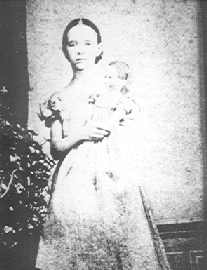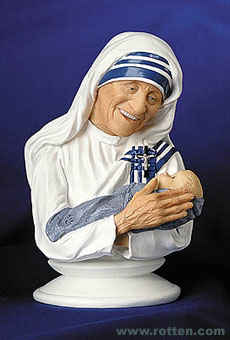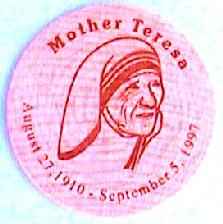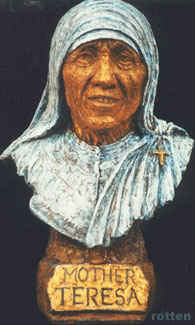|
Mother TeresaEverybody remembers Mother Teresa as a living saint. Mother T was a Catholic nun who helped the destitute and homeless of Calcutta, and who became an international emissary of peace and charity after receiving the Nobel Peace Prize in 1979.
Mother Teresa was born in Macedonia in 1910. Her given name was Agnes Gonxha Bojaxhiu. As a girl she decided to become a missionary, and at age 18 left home to join a convent in Calcutta. She taught at St. Mary's High School until 1948, when she received permission to leave her order and embark on her life's mission of helping the poor. In 1950, she founded The Missionaries of Charity, a religious order dedicated to caring for the indigent residents of Calcutta. In time, the little charity blossomed into a reasonably well-funded endeavor. So far, so good. Then some guy from the BBC shows up in 1969 and points a movie camera at Mother T. The result is the documentary Something Beautiful for God. The hagiography instantly confers celebrity status on its unknown subject. And the film is followed by a book of the same name. Suddenly, Mother Teresa had become a household name. And then something happened.
These stories prompted Mother Teresa to come forward. In the aftermath of the war, thousands of the rape victims were now pregnant. Mother Teresa made public appeals for the women to keep their unborn babies, and not abort them. She offered no condolences for the dead women, no sympathy for the surviving victims, and not a word about the soldiers. Her sole interest in the matter was preventing abortions. Mother T had a lifelong obsession with abortion. It was her central issue. She was fundamentally opposed to it, regardless of circumstances. She was against abortion in all cases, even in the case of rape, incest, or risk to the woman's health. In her acceptance speech for the Nobel Peace Prize in 1976, she made her stance clear: "Abortion is the worst evil, and the greatest enemy of peace ... Because if a mother can kill her own child, what will prevent us from killing ourselves or one another? Nothing." In 1993 she was asked about a case in Ireland about a 14-year-old rape victim. Mother T remarked: "Abortion can never be necessary because it is pure killing." Needless to say, M.T. was equally opposed to contraception in all forms. But her ideals always seemed to take a back seat around her friends, the dictators. In 1975, Indira Ghandi imposed martial law in India. During the two year "state of emergency" she suspended the constitution, imposed censorship on the news media, and arrested her political enemies. Indira's son Sanjay spearheaded an effort in population control for the poor, wherein they were rounded up and forcibly sterilized. Despite her lifelong opposition to contraception and presumptive support for human rights, Mother Teresa chose to embrace the new order and issued a public statement lauding the government's efforts.
She had other questionable supporters as well. Charles Keating, who stole in excess of $252 million in the Savings and Loan scandal of the 1980s, donated $1.25 million of his loot to Mother Teresa. When he was eventually caught, M.T. interceded on his behalf and wrote a letter to the court urging leniency. When the district attorney wrote back informing her that the money she had received was stolen money, she made no attempt to reply. She also accepted money from the embezzler Robert Maxwell, who stole £450 million from his employees' pension funds (and committed suicide rather than face Scotland Yard). In fact, the Missionaries of Charity probably garner annual donations in excess of $100 million worldwide. (It's only "probably" because her organization patently refuses to release their financials.) Where does all that money go?
Of course, when she required her own medical care, only the best would do. In public, she declined a 1984 offer for free cataract surgery from the St Francis Medical Center, worth $5,000. But the following year, she quietly received the same treatment at St. Vincent's Hospital in New York. Not to mention visits to the Scripps Clinic and the Gemelli Hospital, and numerous visits for cardiac care at the Birla Heart Institute in Calcutta. At some point she got a pacemaker installed. And let's not forget that exorcism. During one of her hospitalizations in Calcutta, the local archbishop noticed that Mother T had a habit of fitfully pulling out her EKG sensors at night. He told her that she "might be under the attack of the evil one" and offered to arrange an exorcism. She agreed. After it was over, the archbishop says M.T. "slept like a baby." From which one could reasonably conclude that Satan had indeed been working to possess her. In the April 1996 issue of Ladies Home Journal M.T. disclosed that she wished to finish her life in one of her own Houses of the Dying, just like those poor people she attended to. But when she died the following year, she was in her private bedroom, surrounded by modern cardiac machinery. |
 But nobody seems to remember the crazy things M.T. said about abortion, contraception, and divorce. Or her endless self-aggrandizing through exaggeration and lies. Or the various brutal dictators and other sleazeballs she hung out with. Or especially what happened to all those financial donations (hundreds of millions of dollars) which never seemed to get spent on anything. At least they weren't spent on food, medicine, or housing for the poor.
But nobody seems to remember the crazy things M.T. said about abortion, contraception, and divorce. Or her endless self-aggrandizing through exaggeration and lies. Or the various brutal dictators and other sleazeballs she hung out with. Or especially what happened to all those financial donations (hundreds of millions of dollars) which never seemed to get spent on anything. At least they weren't spent on food, medicine, or housing for the poor.
 In December 1971,
In December 1971,  The western press was shocked. Mother T drew wide criticism for her endorsement, even from the Catholic press. But she never withdrew her comments. And it didn't stop there. In 1981, she flew to Haiti to accept the Legion d'Honneur from Jean-Claude "Baby Doc" Duvalier. In return, she declared that the
The western press was shocked. Mother T drew wide criticism for her endorsement, even from the Catholic press. But she never withdrew her comments. And it didn't stop there. In 1981, she flew to Haiti to accept the Legion d'Honneur from Jean-Claude "Baby Doc" Duvalier. In return, she declared that the  It certainly doesn't go into health care for her wards. People get the misconception that her facilities operate as hospices or medical clinics. This is not so. Those facilities are devoted to giving people someplace to lay down and die. M.T. herself named them "Houses of the Dying." Over the years, her organization has grown to support a worldwide network of schools and soup kitchens, but these are rather modest affairs and require very little cash to maintain. In fact, one former staffer of the New York branch revealed that although there was more than $50 million sitting in the bank, the local subsidiary continued to appeal to the public for more donations. There is no telling how much money resides in all their other accounts around the world.
It certainly doesn't go into health care for her wards. People get the misconception that her facilities operate as hospices or medical clinics. This is not so. Those facilities are devoted to giving people someplace to lay down and die. M.T. herself named them "Houses of the Dying." Over the years, her organization has grown to support a worldwide network of schools and soup kitchens, but these are rather modest affairs and require very little cash to maintain. In fact, one former staffer of the New York branch revealed that although there was more than $50 million sitting in the bank, the local subsidiary continued to appeal to the public for more donations. There is no telling how much money resides in all their other accounts around the world.